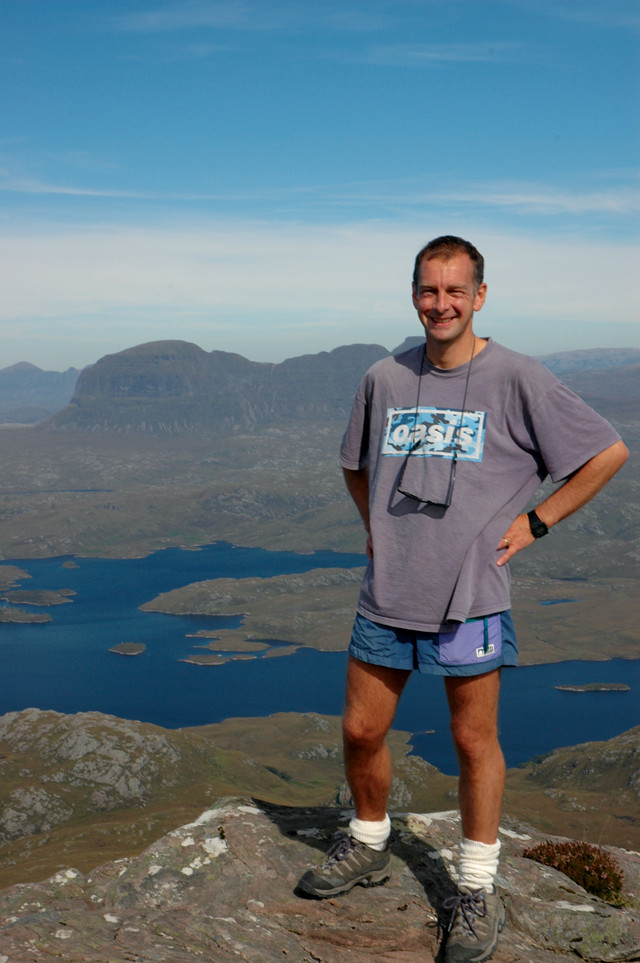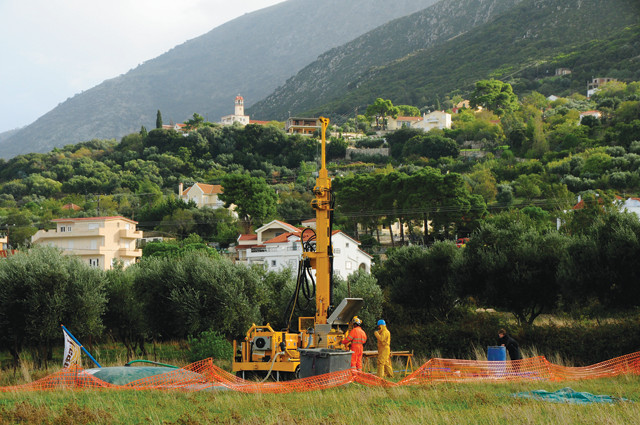
by Erin Wayman Friday, August 25, 2017

John Underhill. Credit: Courtesy of John Underhill.
“The Odyssey” follows Odysseus’ 10-year journey home to Ithaca after the Trojan War. John Underhill, a stratigrapher at the University of Edinburgh in Scotland, has been on his own odyssey over the past seven years — to test whether Ithaca actually existed. For centuries, scholars assumed that the people and places described by Homer in his epic poems were fictional, but archaeological finds elsewhere, such as Troy and Mycenae, have proven that these stories were grounded in reality.
In the case of Ithaca, geology, not archaeology, will likely demonstrate its existence and true location. Although there is an island named Ithaca in the eastern Mediterranean, Underhill and his team of geologists and classic Greek scholars don’t think it’s a match to Homer’s Ithaca. Instead, they are investigating if the Paliki Peninsula on the neighboring island of Kefalonia is a candidate for Odysseus’ homeland. In the past, they argue, a marine channel may have cut off the peninsula from the rest of the island. Later, landslides, rockfalls and tectonic uplift filled the intervening valley and joined the two islands together. If true, then Paliki fits Homer’s description of Ithaca as the westernmost island in a cluster of four islands.
Underhill has had more time to lead this expedition since retiring from his second job in 2008: For 28 years, he was a football (or soccer, in the U.S.) referee — rising to the heights of the Scottish Premier League and other European leagues — while also working at the university. Underhill talked with EARTH’s Erin Wayman about how he has occupied his new free time with investigations into Ithaca.
EW: How did you get involved in the search for Ithaca?
JU: I was lucky enough to do a Ph.D. in tectonics and sedimentation in western Greece in the 1980s. What happened was a chap named Robert Bittlestone — who was a Greek scholar by training and did an undergraduate degree in that discipline — reread “The Odyssey.” There’s text therein that suggests [Homer’s] Ithaca lay to the west [of three other islands] — toward dusk and not toward the dawn [in contrast to modern Ithaca, which lies to the east]. And it’s surrounded by three islands, not two as in the present day. [Bittlestone’s former advisor, James Diggle of the University of Cambridge, got involved], and went back to the ancient Greek. There was the possibility that [the poem] could have been handed down over the years and corrupted so that west meant east and four meant three. James said that’s not possible with the way the poem is constructed.
They decided that it was a geological problem: Could the western peninsula of Kefalonia have been an island 2,000 to 3,000 years ago? If it were, how would we know? They needed a geologist. This is where it gets quite unusual and amusing, but also shows the power of the Internet. They simply punched into Google “Kefalonia Geology” and my name came up … and James and Robert rang me up. … I was tentative, but listened. What they [said] was: Can you as a geologist either demonstrate this is the case or disprove it? For me, to go back to an area I knew well and to look beneath the ground and test whether this valley — which is now filled with material — could have been an open marine channel in Mycenaean times was too exciting a geological challenge to ignore.
EW: When they first called, did you think it was possible that the peninsula had been an island?
JU: To be honest, I thought it was possible but not likely. And if I’m being completely frank, I think I would say I thought it would be relatively easy to disprove … but strangely enough that’s not what happened.
However unlikely it seems, the geoscience evidence suggests not only is it possible but it’s plausible, and there’s now a mechanism we understand that was previously undetectable because we couldn’t look beneath the surface. We’ve thrown so much high-tech geophysics [at the problem] and then ground-truthed that with boreholes. There have been 15 boreholes drilled on land that allow us to calibrate the geophysical observations and the remote sensing observations. It now means we probably understand this narrow valley in Kefalonia better than any other in the Mediterranean.
EW: What do the data reveal?
JU: Between 2003 and 2006 we were able to do field investigations on the surface. … As a result of that work, [the geotechnical company] Fugro came in to lend their expertise and equipment. We’ve [had] a very thorough land, sea and air campaign. We’ve flown helicopters to undertake electromagnetic and resistivity surveys, we’ve had a marine vessel shooting seismic reflection data, and we’ve had land surveys for gravity, resistivity and magnetics. The results have been of exceptional high fidelity and provide an effective three-dimensional body scan, or X-ray, of this valley and the offshore parts buried beneath the neighboring Gulf of Livadi.
On the basis of the results, [we] selected strategic locations to drill boreholes and to continuously core them. We [brought] up sedimentary samples … which we have dated and logged to find out whether they’re marine or nonmarine, what the caliber of the sediment is, and what they tell us about depositional processes and tectonic processes.
From the surface geology, it appeared that marine waters [would have most recently flowed through the valley sometime] on the order of 15 million years ago. However, the boreholes show that marine waters flowed through this valley much more recently, during Pleistocene times, and [the valley was] cut through by a series of steeply inclined faults, thrust planes, that have uplifted the whole area, lifting it into a bow shape such that the valley rises to 175 meters at its saddle. But [that uplift happened] after this [very young] marine sediment went all the way through. That demonstrates that marine waters passed through this valley much [more recently] than anyone realized, something that lends some support to the theory being tested.
EW: Are there ways to figure out how recently marine waters flowed through the valley?
JU: On top of all this material is a silted-up lakebed, which was deposited on top of everything after the deformation. What we’re attempting to do next is to get some radiocarbon dates and some palynological [pollen] dates of the oldest sediments beneath the lake. We’re exporting the cores … to North Wales to Fugro, which has expertise in radiocarbon, micropaleontological and palynological techniques.
If the lake sediments are greater than 3,000 years old, then [the idea that Paliki is Ithaca] is a nice theory but it doesn’t work in the timeframe described in the Homeric text. However, if those lake sediments are, let’s say, 1,500, 1,000 or 500 years old, then it’s still game on — the lake is younger than all the deformation.
EW: If the age is right, will that be enough evidence to satisfy your curiosity?
JU: I think in terms of this particular theory that would be as far as we can take it at the present time. However, there are other geological prizes to be researched. … Kefalonia is tectonically the most active part of Western Europe. Because Kefalonia sits where it does and because it’s being uplifted — and because of the marine seismic [data] we’ve collected — we have a unique opportunity to understand the interplay between tectonics, climate and sea-level change over the last 22,500 years if we were ever able to bring a marine vessel into the Gulf of Livadi to drill and core the crucial boreholes.
Normally, in most places that are tectonically stable, all you see is the gradual progressive sea-level rise since the last glacial maximum 22,000 years ago. In Kefalonia … at certain times, sea level [fell] instantaneously due to one earthquake on one day. For instance, in 1953, there was an earthquake of magnitude 7.2 that struck the island and uplifted it by 60 centimeters, so there was a 60-centimeter sea-level fall in one day. There are other wave-cut notches and raised beaches that demonstrate that in Kefalonia, although the uplift is punctuated, it is occurring at a greater rate than sea-level rise in some places some of the time. … It would be a unique and dramatic example of being able to sample and analyze the sediments to see the effects of and interaction between tectonics, climate and global sea-level rise and to possibly date them — and to link it back to classical Greek scholarship and archaeology to see how this impacted Bronze Age or Roman existence.

John Underhill and his colleagues have drilled 15 boreholes in Kefalonia to collect sedimentary samples. The samples show that Paliki was once separated from the rest of the island by a marine channel. The team is now trying to date when this happened. Credit: Courtesy of John Underhill.
EW: I also wanted to ask you about your career in soccer. It’s hard to imagine an academic would have time to be a professional referee. How did you balance those two careers?
JU: As you might imagine, I had a lot of support from colleagues, students and the university to undertake that dual career. I was very fortunate in football because I was also operating on the European circuit, so I often officiated on international matches or games between European clubs as well as those operating here in Scotland. That meant quite a bit of travel. … I had to have very understanding and sympathetic employers and students.
What I have noticed is having retired — you’re forced to retire [in refereeing], there’s an age limit — I’m lucky I got away scot-free without being dogged by major controversy. … And secondly, and perhaps more significantly, I have found the amount of time that I’ve got back that I put back into geology is remarkable. Before, I was much more selective [in choosing projects], by necessity. When I retired, my daughter Laura said something that’s bittersweet: “It’s good to have you back, Dad.” If you look at it one way, it’s nice to know that I’m now around to offer appreciated support at a key time in her life. And then you look at it another way and think: Was I away? [Laughs] There are lots of pros and cons to the whole thing. But I never regret it at all. It was a fantastic experience.
© 2008-2021. All rights reserved. Any copying, redistribution or retransmission of any of the contents of this service without the expressed written permission of the American Geosciences Institute is expressly prohibited. Click here for all copyright requests.